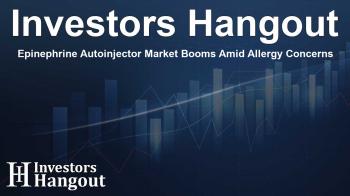Epinephrine Autoinjector Market Booms Amid Allergy Concerns

Growth of the Epinephrine Autoinjector Market
The epinephrine autoinjector market is experiencing substantial growth, estimated to increase by USD 2.44 billion from 2024 to 2028. This remarkable expansion is largely attributed to the rising prevalence of allergies and the increasing awareness surrounding these life-saving devices. During this period, the market is expected to grow at a compound annual growth rate (CAGR) of over 10.59%. As more individuals become aware of the importance of having autoinjectors on hand for severe allergic reactions, the market dynamics are set to evolve significantly.
Market Drivers and Innovations
Numerous factors are fueling the growth of the epinephrine autoinjector market. One of the key drivers is the surge in allergy incidents, prompting healthcare professionals to recommend these devices for immediate intervention during acute reactions. Devices, such as epinephrine pens and auto-injectors, are essential for treating anaphylaxis resulting from food allergies, insect stings, and other triggers.
Innovations in product design, including needle-free options, are enhancing usability and making treatment more accessible. This shift towards user-friendly autoinjectors aligns with a growing trend among patients who prefer devices that allow for self-administration. Companies are developing new formulations and delivery systems aimed at increasing safety and effectiveness, thereby contributing to the market's expansion.
Key Challenges in the Market
While the outlook for the epinephrine autoinjector market appears positive, several challenges remain. Recurring product recalls pose threats to consumer trust and can hinder market growth. Manufacturers must navigate stringent regulations set forth by health authorities, which can delay the introduction of new products.
Additionally, the current landscape indicates a shift towards more competitive pricing, as generics are introduced into the market. With the pressure from health authorities for government approval, generic alternatives are becoming more prevalent. Companies such as Amphastar and Viatris are leading this initiative, responding to public demand for affordable and accessible treatment options.
Segment Analysis
Types of Epinephrine Autoinjectors
The market is segmented based on the type of epinephrine dosage available. The most common segments include 0.30gm, 0.15gm, and 0.50gm formulations. The demand for these devices varies among consumers, with specific age groups and healthcare needs playing a crucial role in determining the ideal product fit.
Geographical Insights
Geographical trends reveal variations in market penetration. Following increased governmental initiatives, the US is witnessing a rise in new product launches. Attention is being directed at expanding the market share across Europe and Asia as well, driven by growing awareness and regulatory support.
Future Outlook and Opportunities
Looking ahead, the epinephrine autoinjector market has numerous opportunities for expansion. Companies can innovate further by embracing digital health solutions and training applications to educate patients about proper usage and self-administration of autoinjectors. Efforts to increase public awareness around allergies will also foster market growth.
As innovations continue, the collaboration among market players will be essential for navigating regulatory hurdles while delivering safe, effective products that meet patient needs. By focusing on R&D and strategic partnerships, companies can position themselves favorably in this competitive landscape.
Frequently Asked Questions
What is driving the growth of the epinephrine autoinjector market?
The growth of the epinephrine autoinjector market is primarily driven by the rising prevalence of allergies and increased awareness of the importance of these life-saving devices.
What are the major challenges facing the market?
Major challenges include recurring product recalls, regulatory hurdles, and competition from generic alternatives impacting pricing and consumer trust.
What types of epinephrine autoinjectors are available?
Epinephrine autoinjectors are available in different dosages, including 0.30gm, 0.15gm, and 0.50gm, catering to various patient needs and age groups.
How is innovation impacting the autoinjector market?
Innovation is crucial as manufacturers develop user-friendly designs, including needle-free injectors that enhance convenience and accessibility for consumers.
What does the future hold for the epinephrine autoinjector market?
The future looks promising with opportunities for expansion through digital health solutions and increased public awareness surrounding allergies.
About Investors Hangout
Investors Hangout is a leading online stock forum for financial discussion and learning, offering a wide range of free tools and resources. It draws in traders of all levels, who exchange market knowledge, investigate trading tactics, and keep an eye on industry developments in real time. Featuring financial articles, stock message boards, quotes, charts, company profiles, and live news updates. Through cooperative learning and a wealth of informational resources, it helps users from novices creating their first portfolios to experts honing their techniques. Join Investors Hangout today: https://investorshangout.com/
Disclaimer: The content of this article is solely for general informational purposes only; it does not represent legal, financial, or investment advice. Investors Hangout does not offer financial advice; the author is not a licensed financial advisor. Consult a qualified advisor before making any financial or investment decisions based on this article. The author's interpretation of publicly available data presented here; as a result, they should not be taken as advice to purchase, sell, or hold any securities mentioned or any other investments. If any of the material offered here is inaccurate, please contact us for corrections.
